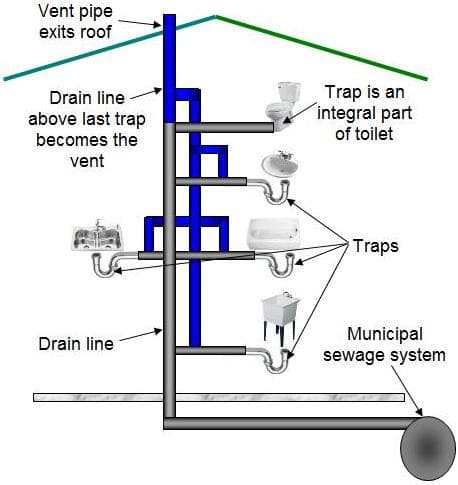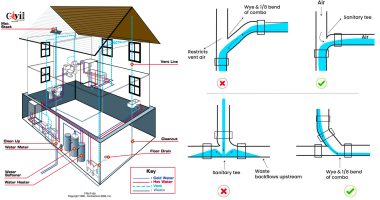Presented here down the page you can find additional really good resources about Plumbing Installation 101: All You Need to Know.

Comprehending how your home's pipes system works is vital for each property owner. From supplying tidy water for alcohol consumption, food preparation, and showering to safely removing wastewater, a well-maintained pipes system is crucial for your household's health and convenience. In this thorough guide, we'll explore the intricate network that makes up your home's pipes and deal ideas on maintenance, upgrades, and dealing with common concerns.
Introduction
Your home's pipes system is greater than just a network of pipes; it's an intricate system that ensures you have access to tidy water and reliable wastewater elimination. Understanding its components and exactly how they work together can aid you avoid costly repair work and ensure every little thing runs smoothly.
Standard Components of a Pipes System
Pipes and Tubes
At the heart of your plumbing system are the pipelines and tubing that lug water throughout your home. These can be made of different materials such as copper, PVC, or PEX, each with its advantages in regards to longevity and cost-effectiveness.
Fixtures: Sinks, Toilets, Showers, and so on.
Components like sinks, toilets, showers, and bath tubs are where water is utilized in your home. Recognizing how these components connect to the pipes system assists in diagnosing troubles and preparing upgrades.
Shutoffs and Shut-off Points
Valves regulate the circulation of water in your plumbing system. Shut-off shutoffs are important during emergency situations or when you need to make fixings, enabling you to isolate parts of the system without disrupting water circulation to the entire house.
Supply Of Water System
Key Water Line
The main water line attaches your home to the municipal water or a private well. It's where water enters your home and is distributed to numerous fixtures.
Water Meter and Pressure Regulatory Authority
The water meter steps your water usage, while a stress regulator makes sure that water flows at a secure stress throughout your home's plumbing system, stopping damage to pipes and components.
Cold Water vs. Hot Water Lines
Recognizing the difference in between cold water lines, which supply water straight from the major, and warm water lines, which carry heated water from the hot water heater, helps in troubleshooting and preparing for upgrades.
Water drainage System
Drain Pipes Pipes and Traps
Drain pipes bring wastewater far from sinks, showers, and bathrooms to the sewage system or sewage-disposal tank. Traps protect against drain gases from entering your home and additionally trap debris that can cause blockages.
Air flow Pipelines
Ventilation pipes permit air into the drain system, stopping suction that might reduce drainage and trigger catches to empty. Appropriate air flow is crucial for maintaining the stability of your pipes system.
Relevance of Proper Drain
Making sure appropriate water drainage prevents backups and water damage. On a regular basis cleaning up drains pipes and maintaining traps can stop pricey repairs and extend the life of your plumbing system.
Water Heating Unit
Types of Water Heaters
Hot water heater can be tankless or standard tank-style. Tankless heating systems heat water on demand, while containers store heated water for immediate use.
How Water Heaters Link to the Plumbing System
Comprehending how water heaters link to both the cold water supply and hot water distribution lines assists in identifying problems like insufficient hot water or leakages.
Upkeep Tips for Water Heaters
Consistently purging your hot water heater to get rid of debris, examining the temperature level setups, and checking for leaks can extend its lifespan and improve energy efficiency.
Typical Pipes Concerns
Leakages and Their Reasons
Leakages can happen because of aging pipelines, loosened installations, or high water pressure. Dealing with leaks promptly prevents water damages and mold and mildew development.
Obstructions and Obstructions
Blockages in drains and toilets are often brought on by purging non-flushable products or an accumulation of grease and hair. Using drainpipe screens and being mindful of what decreases your drains pipes can avoid clogs.
Signs of Pipes Issues to Look For
Low tide pressure, slow drains pipes, foul odors, or abnormally high water expenses are signs of possible pipes problems that should be dealt with immediately.
Plumbing Maintenance Tips
Routine Inspections and Checks
Set up yearly plumbing examinations to catch concerns early. Try to find signs of leakages, rust, or mineral buildup in taps and showerheads.
DIY Upkeep Tasks
Basic tasks like cleansing faucet aerators, checking for commode leakages using color tablets, or insulating subjected pipes in cool climates can prevent major pipes issues.
When to Call a Professional Plumber
Know when a pipes issue needs professional experience. Attempting intricate repair work without correct understanding can bring about more damages and higher repair work expenses.
Updating Your Plumbing System
Factors for Upgrading
Updating to water-efficient components or replacing old pipelines can enhance water quality, decrease water bills, and boost the value of your home.
Modern Pipes Technologies and Their Benefits
Explore modern technologies like smart leakage detectors, water-saving bathrooms, and energy-efficient water heaters that can conserve money and minimize ecological impact.
Price Considerations and ROI
Determine the ahead of time costs versus long-lasting financial savings when thinking about pipes upgrades. Several upgrades spend for themselves through decreased energy costs and fewer repair work.
Ecological Impact and Conservation
Water-Saving Fixtures and Home Appliances
Mounting low-flow faucets, showerheads, and toilets can substantially lower water use without sacrificing performance.
Tips for Reducing Water Usage
Easy behaviors like fixing leaks quickly, taking much shorter showers, and running complete lots of laundry and dishes can save water and lower your utility expenses.
Eco-Friendly Pipes Options
Take into consideration lasting pipes products like bamboo for floor covering, which is durable and eco-friendly, or recycled glass for countertops.
Emergency Preparedness
Steps to Take Throughout a Pipes Emergency situation
Know where your shut-off shutoffs lie and just how to shut off the water in case of a ruptured pipe or major leak.
Value of Having Emergency Contacts Handy
Maintain call info for regional plumbings or emergency solutions conveniently available for quick action during a plumbing situation.
Do It Yourself Emergency Situation Fixes (When Relevant).
Momentary solutions like making use of duct tape to spot a dripping pipeline or placing a bucket under a dripping faucet can lessen damages up until a specialist plumbing technician gets here.
Conclusion.
Understanding the anatomy of your home's pipes system encourages you to maintain it efficiently, saving money and time on repairs. By following routine maintenance routines and remaining informed about modern-day plumbing innovations, you can guarantee your pipes system operates effectively for several years to come.
HOW YOUR PLUMBING SYSTEM WORKS
Which Pipes Do What?
- Blue lines = fresh water supply entering the building
- Red lines = hot water supply entering the building
- Grey lines = pipes carrying waste away from the building and venting pipes carrying gases away from the building (through the roof)
YOUR MAIN PLUMBING SYSTEMS
There are two main plumbing systems that support your home s basic plumbing needs one that brings clean water into your home, and one that sends dirty water away from your home. Connected to the toilet, bath, shower, and other faucets in your home, these two systems keep your water flowing in the right directions.
ACCESSING FRESH WATER
Fresh and clean water is brought into your home through the main water supply line . Filtered through one pipe, this water is pressured to flow into the various fixtures in your home at any given time.
This water can be sourced from a well located on your property, a pond or river (mostly cottages), or, as in most cases, from the city s municipal water treatment centre. However, it is important to note that water that is untreated, such as the water siphoned from ponds or rivers, may not be safe to drink. Personal water supplies always need to be treated for hardness and contaminants before consumed.
MUNICIPAL WATER SUPPLIES
- Improve taste and odour
- Remove sediment
- Eliminate hardness
- Reduce chlorine
COLD WATER SUPPLY VS. HOT WATER SUPPLY
Cold water flows into your home or building through the service line, which then distributes hot or cold water to your fixtures. This line is most commonly run through a central column that runs floor to floor. Hot water runs in short and straight pipes as the longer the pipeline, the more heat that will be lost in the transfer. Having shorter pipes also allows residents to access hot water more quickly.
WASTE WATER SYSTEM
Your wastewater system is divided into two parts pipes that send wastewater away from your home and venting pipes that send sewer gas away from your home. Sewage water travels through pipes that flush the water and waste towards local sewers that are operated and managed by your city or town. Most sewer systems rely on gravity to move the wastewater to where it needs to go.
The further away from your toilet or sink, the larger wastewater pipes become. This allows for waste to be disposed of from various parts of your home or business at once without pipe blockages. The angle and flow of these pipes are also essential for keeping your waste pipes clear of build up.
https://harrisplumbing.ca/how-your-home-plumbing-system-works/

I'm very excited about Plumbing Installation 101: All You Need to Know and I'm hoping you enjoyed the blog posting. Those who liked our article if you please consider to pass it around. Thanks so much for going through it.
Customer Reviews
Comments on “The Main Elements of Your Home's Plumbing System”